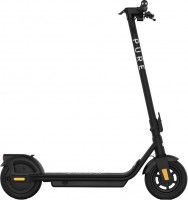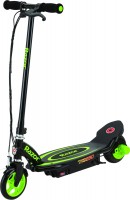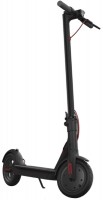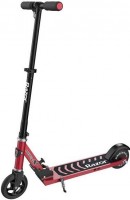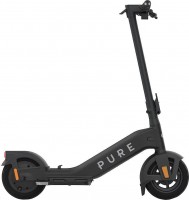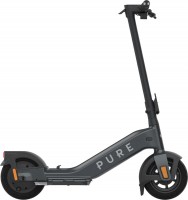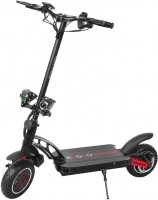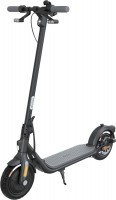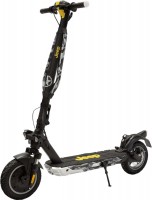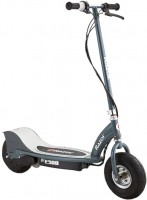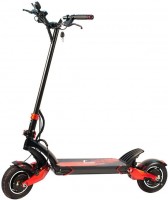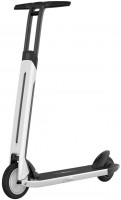Electric Scooters Ninebot
You might be interested in
Articles, reviews, useful tips
All materials
How to choose a reliable stunt scooter or everything you need to know about compression systems
Educational programme on the types of compressions on which the reliability, weight and ease of maintenance of the scooter depends

The best lightweight electric scooters (up to 12.5 kg)
Electric scooters weighing up to 12.5 kg for comfortable use in urban environments

How to choose a scooter for an adult
Which scooter to choose: urban, stunt or electric and what you should pay attention to

The best electric scooters with a maximum load of 100+ kg
Electric scooters that are designed for heavy users

The best stunt scooters
Scooters with an increased margin of safety, a reliable compression system and other features

The best electric scooters with extended range
Electric vehicles of a new era with an autonomous range of over 40 km on a single battery charge
Electric Scooters: specifications, types
Show all
Max. load
The maximum weight of the rider that the design of the scooter can withstand without breakdowns and accidents. This moment is partly determined by the age group, and mainly by the materials used in the frame. Note that manufacturers can indicate the maximum load for perfect conditions - when the scooter rides on a perfectly flat surface or even stands still. Therefore, it is worth choosing a model for this parameter with a certain margin. And even more so, you should not exceed the weight indicated in the characteristics - even if the scooter does not break down immediately, this can happen at any time after, which is fraught with accidents and injuries.
Foldable
The ability to fold the scooter – usually by "laying" the steering wheel in a horizontal position, on the platform; in some models, the handles on the steering wheel are also foldable. This feature greatly simplifies storage and transportation while not in use.
Range
The maximum distance that an electric scooter can travel on a single battery charge.
Usually the range is indicated for a flat road and driving only on an electric motor, without the help of a rider. So this indicator is quite conditional, in practice, the distance of the trip may be either less or more, depending on the characteristics of the road and driving style. Nevertheless, according to the claimed range, it is quite possible to estimate the autonomy of different models and compare them with each other.
Note that a large range (more than 50 km) requires capacious batteries, which affects the dimensions and weight of the device. The real need for such autonomy is not required so often, especially since many electric scooters are quite capable of driving in the usual way, without the use of an electric motor.
Usually the range is indicated for a flat road and driving only on an electric motor, without the help of a rider. So this indicator is quite conditional, in practice, the distance of the trip may be either less or more, depending on the characteristics of the road and driving style. Nevertheless, according to the claimed range, it is quite possible to estimate the autonomy of different models and compare them with each other.
Note that a large range (more than 50 km) requires capacious batteries, which affects the dimensions and weight of the device. The real need for such autonomy is not required so often, especially since many electric scooters are quite capable of driving in the usual way, without the use of an electric motor.
Power
The power of the motor installed in the electric scooter. In models with two motors (one per wheel), their total power is usually indicated.
A more powerful motor, on the one hand, has a positive effect on the speed and acceleration characteristics; on the other hand, it affects the cost of the device and requires more capacious batteries, which affect both the price and weight. In addition, at acceleration and low speeds, the scooter can be “helped” by pushing off with your foot. Therefore, in most modern models, the motor power is low — most often in range of 250 W, 300 W, 350 W. Power of 500 W is considered quite high, it allows you to reach speeds of 40 km/h and even higher. In the most advanced models, power is already measured in kilowatts, and the maximum speed can exceed 80 km/h; however, such "monsters" cost accordingly.
However, power also affects the ability to drive a vehicle, because depending on the country, various traffic rules are provided for driving a scooter.
A more powerful motor, on the one hand, has a positive effect on the speed and acceleration characteristics; on the other hand, it affects the cost of the device and requires more capacious batteries, which affect both the price and weight. In addition, at acceleration and low speeds, the scooter can be “helped” by pushing off with your foot. Therefore, in most modern models, the motor power is low — most often in range of 250 W, 300 W, 350 W. Power of 500 W is considered quite high, it allows you to reach speeds of 40 km/h and even higher. In the most advanced models, power is already measured in kilowatts, and the maximum speed can exceed 80 km/h; however, such "monsters" cost accordingly.
However, power also affects the ability to drive a vehicle, because depending on the country, various traffic rules are provided for driving a scooter.
Max. power
The power in watts that the electric scooter motor can develop at maximum speed. In general, for scooters with an electric drive, it is customary to indicate the rated engine power (see above), which ensures efficient operation of the motor for a long time. By maximum we mean power in the “gas to the floor” mode, achieved only in the short term. Using this parameter, you can roughly estimate the capabilities of a particular model, for example, in terms of speed dynamics - the more power, the faster the scooter accelerates.
Max. speed
A high top speed gives you more riding options and reduces travel time. However, it requires powerful motors and capacious batteries, which affects the price and weight of the scooter. In addition, the faster the scooter, the more careful you need to be when driving. Therefore, most of the electric scooters have a speed of 25 km / h or a little more - 30 km / h.
Speed modes
The number of speed modes in the electric scooter. By switching between them, the rider has the right to choose the most comfortable pace of the trip and change the upper speed limit bar.
Pedestrian mode
The slowest speed mode (approximately from 0 to 5 – 6 km/h), ideal for use in crowded places, children and beginners. It controls the e-scooter while it moves at a safe speed for pedestrians to avoid collisions on crowded sidewalks. Pedestrian mode is also suitable for leisurely walks and side-by-side trips with walking friends.
Max. climbing angle
The maximum climbing angle that an electric scooter can overcome on engine power alone, without the help of legs. Models with engines of the same power may differ in this indicator (due to the difference in torque and wheel size).
Note that in the specifications the angle is usually indicated in degrees, while on road signs it is given as a percentage (1% corresponds to a rise of 1 m for every 100 m of horizontal movement). However, this moment is not particularly critical: if you often have to overcome a certain hill, you can clarify its slope by converting percentages into degrees (and vice versa) according to special tables. In addition, if the angle turns out to be too large, nothing prevents you from helping the scooter with your foot, in extreme cases, to overcome the climb on foot.
Note that in the specifications the angle is usually indicated in degrees, while on road signs it is given as a percentage (1% corresponds to a rise of 1 m for every 100 m of horizontal movement). However, this moment is not particularly critical: if you often have to overcome a certain hill, you can clarify its slope by converting percentages into degrees (and vice versa) according to special tables. In addition, if the angle turns out to be too large, nothing prevents you from helping the scooter with your foot, in extreme cases, to overcome the climb on foot.
Drive
The type of drive in the design of the scooter determines to which wheels the traction from the electric motor is transmitted.
- Front. The drive to the front wheel pulls the entire electric scooter. It provides improved stability on the road, minimizes the likelihood of skidding in corners, and guarantees a soft start and smooth acceleration. On the other hand, the electric motor at the front increases the weight of the wheel assembly and increases the effort when turning the handlebar.
- Rear. Rear-wheel drive electric scooters are not as stable on the road as front-wheel drive models. However, they are more frisky, demonstrate dynamic acceleration and easily conquer hills.
- All-wheel. Scooters with all-wheel drive combine all the positive qualities of front- and rear-wheel drive models in one package. They are also best suited for off-road driving — the all-wheel drive chassis does not care about pits and steep hills, other road irregularities, or mud deposits on the road.
- Front. The drive to the front wheel pulls the entire electric scooter. It provides improved stability on the road, minimizes the likelihood of skidding in corners, and guarantees a soft start and smooth acceleration. On the other hand, the electric motor at the front increases the weight of the wheel assembly and increases the effort when turning the handlebar.
- Rear. Rear-wheel drive electric scooters are not as stable on the road as front-wheel drive models. However, they are more frisky, demonstrate dynamic acceleration and easily conquer hills.
- All-wheel. Scooters with all-wheel drive combine all the positive qualities of front- and rear-wheel drive models in one package. They are also best suited for off-road driving — the all-wheel drive chassis does not care about pits and steep hills, other road irregularities, or mud deposits on the road.
Wheels
The type and size of wheels used in an electric scooter.
The size is selected by the manufacturer depending on the general purpose of the scooter - whether it is an asphalt road or rough terrain. If we compare similar models with different wheel diameters, then it is worth considering that the larger the wheels ( 10" and larger), the better they handle road unevenness, the higher the cross-country ability and softness of the ride. And small wheels (for example, 8") in turn, they are excellent for smooth asphalt and dynamic driving; they accelerate easily and allow you to make sharp turns.
As for the different types of wheels, there are polyurethane, rubber, inflatable. More details about each:
- Polyurethane. Wheels with solid polyurethane tires. This material provides good shock absorption, high-quality road grip and at the same time good rolling ability; it is resistant to temperature changes and damage, durable, and inexpensive.
— Solid rubber. In this case, we mean wheels with solid rubber tires (inflatable wheels are taken to a separate selection point). In terms of its main characteristics, rubber is similar to the polyurethane described above, and in some respects even surpasses it. Thus, such tires do not make nois...e, smooth out asphalt roughness well, have excellent grip and provide high braking efficiency. On the other hand, this material is less durable and does not tolerate temperature changes well.
— Rubber inflatable. The most advanced type of wheels found in modern scooters. This type of wheel has an inflatable tire (like a bicycle), which provides excellent shock absorption, tight traction and high maneuverability. The disadvantages of inflatable tires, in addition to the price, include sensitivity to punctures and increased difficulty in maintenance: you need to monitor the pressure and, if necessary, inflate the tire.
— Rubber gel. Tubeless wheels filled with gel are insensitive to minor punctures and cuts. Coming out, the gel in the tire hardens almost instantly upon contact with air, effectively sealing the damaged area. In addition, such wheels require virtually no maintenance - they do not need to be inflated. The disadvantages of gel tires include their high cost and somewhat greater rigidity than inflatable tires (although such wheels are still noticeably superior to rubber wheels in terms of softness).
The size is selected by the manufacturer depending on the general purpose of the scooter - whether it is an asphalt road or rough terrain. If we compare similar models with different wheel diameters, then it is worth considering that the larger the wheels ( 10" and larger), the better they handle road unevenness, the higher the cross-country ability and softness of the ride. And small wheels (for example, 8") in turn, they are excellent for smooth asphalt and dynamic driving; they accelerate easily and allow you to make sharp turns.
As for the different types of wheels, there are polyurethane, rubber, inflatable. More details about each:
- Polyurethane. Wheels with solid polyurethane tires. This material provides good shock absorption, high-quality road grip and at the same time good rolling ability; it is resistant to temperature changes and damage, durable, and inexpensive.
— Solid rubber. In this case, we mean wheels with solid rubber tires (inflatable wheels are taken to a separate selection point). In terms of its main characteristics, rubber is similar to the polyurethane described above, and in some respects even surpasses it. Thus, such tires do not make nois...e, smooth out asphalt roughness well, have excellent grip and provide high braking efficiency. On the other hand, this material is less durable and does not tolerate temperature changes well.
— Rubber inflatable. The most advanced type of wheels found in modern scooters. This type of wheel has an inflatable tire (like a bicycle), which provides excellent shock absorption, tight traction and high maneuverability. The disadvantages of inflatable tires, in addition to the price, include sensitivity to punctures and increased difficulty in maintenance: you need to monitor the pressure and, if necessary, inflate the tire.
— Rubber gel. Tubeless wheels filled with gel are insensitive to minor punctures and cuts. Coming out, the gel in the tire hardens almost instantly upon contact with air, effectively sealing the damaged area. In addition, such wheels require virtually no maintenance - they do not need to be inflated. The disadvantages of gel tires include their high cost and somewhat greater rigidity than inflatable tires (although such wheels are still noticeably superior to rubber wheels in terms of softness).
Front brake
Among the various types of brakes in scooters, you can find rim, disc, drum, electric. There are also models without a front brake.
- Rim. The rim brake is considered the simplest type of braking system. Such brakes provide a smooth deceleration and a complete stop of the scooter at an average speed. The stopping distance is usually medium or long. The rim brake is represented by pads, which, using a special mechanism, are pressed against the wheel rim. The pads themselves are driven by a lever, which is placed on the handlebar. Among the advantages of a rim brake are low price, and simple design. And drawbacks are fairly quick wear of the pads and the need to adjust the brakes as the friction linings wear out. Additionally, when using a scooter with a rim brake, be aware that the pads become less grippy if the rim is wet. In rainy, cloudy and slushy weather, the rim brake cannot be relied upon.
— Disk. Disc brakes are considered more advanced than rim brakes. The disc brake allows the scooter to stop quickly enough, and the braking distance itself can be either minimal or medium. Such brakes are represented by a friction clutch that acts on a small-diameter disc. The disc is attached to the wheel axle. The clutch is pressed against the brake disc with a sufficiently large force, which allows the disc brakes to b...e effective even when wet on the clutch. The disc brake is controlled by a lever that is placed on the handlebar. The advantages of a disc brake for a scooter are reliability, durability and the ability to stop quickly. Among the shortcomings, we highlight the high price and the need to adjust as the friction clutch wears out.
- Drum. Drum brakes slow down well and provide a fairly quick stop. In terms of efficiency, the drum brake for a scooter is between the rim and disc brake systems. The drum brake uses pads that are located inside the rim. In this case, the friction plates act on the inside of the rim. The brake with a drum device has many advantages: a large friction contact surface, moisture protection, reliability and durability. Among the shortcomings can be noted: the use of massive wheels, the complexity of service maintenance, and the need for periodic adjustment.
- Electric — braking with the help of recuperation. In this case, the deceleration and stop are produced by the electric motor itself, by reducing the speed. Usually, the electric brake provides a soft and smooth stop. As a rule, the electric brake acts as an auxiliary brake system. Also, advanced scooters often use a recuperative electric brake. In this case, when the speed is slowed down, energy is recovered, which allows you to recharge the battery pack.
- No brake. The front wheel is not equipped with a brake system. The braking can only be provided at the rear.
- Rim. The rim brake is considered the simplest type of braking system. Such brakes provide a smooth deceleration and a complete stop of the scooter at an average speed. The stopping distance is usually medium or long. The rim brake is represented by pads, which, using a special mechanism, are pressed against the wheel rim. The pads themselves are driven by a lever, which is placed on the handlebar. Among the advantages of a rim brake are low price, and simple design. And drawbacks are fairly quick wear of the pads and the need to adjust the brakes as the friction linings wear out. Additionally, when using a scooter with a rim brake, be aware that the pads become less grippy if the rim is wet. In rainy, cloudy and slushy weather, the rim brake cannot be relied upon.
— Disk. Disc brakes are considered more advanced than rim brakes. The disc brake allows the scooter to stop quickly enough, and the braking distance itself can be either minimal or medium. Such brakes are represented by a friction clutch that acts on a small-diameter disc. The disc is attached to the wheel axle. The clutch is pressed against the brake disc with a sufficiently large force, which allows the disc brakes to b...e effective even when wet on the clutch. The disc brake is controlled by a lever that is placed on the handlebar. The advantages of a disc brake for a scooter are reliability, durability and the ability to stop quickly. Among the shortcomings, we highlight the high price and the need to adjust as the friction clutch wears out.
- Drum. Drum brakes slow down well and provide a fairly quick stop. In terms of efficiency, the drum brake for a scooter is between the rim and disc brake systems. The drum brake uses pads that are located inside the rim. In this case, the friction plates act on the inside of the rim. The brake with a drum device has many advantages: a large friction contact surface, moisture protection, reliability and durability. Among the shortcomings can be noted: the use of massive wheels, the complexity of service maintenance, and the need for periodic adjustment.
- Electric — braking with the help of recuperation. In this case, the deceleration and stop are produced by the electric motor itself, by reducing the speed. Usually, the electric brake provides a soft and smooth stop. As a rule, the electric brake acts as an auxiliary brake system. Also, advanced scooters often use a recuperative electric brake. In this case, when the speed is slowed down, energy is recovered, which allows you to recharge the battery pack.
- No brake. The front wheel is not equipped with a brake system. The braking can only be provided at the rear.
Rear brake
Like a handbrake, the rear brake can be drum, electric, or disc. In addition, there may still be a classic foot brake, as in ordinary scooters, or not at all.
— Disk. The disc brake on the rear wheel ensures a quick stop of the scooter. These brakes have a short-stroke friction clutch. Due to the small distance between the pads and the disc, the friction clutch very quickly comes into contact with the working surface of the brake disc. In this case, the friction clutch is pressed against the disk with a sufficiently large force. The disc brake allows the scooter to stop extremely efficiently. But when using a disc brake on the rear wheel, you should be careful, because when braking hard, especially when cornering, the scooter can skid to the side.
- Drum. The drum type brake has above average efficiency. The drum brake makes the rear wheel massive and heavy. This type of brake has a closed design. The pads are inside the wheel. Friction linings rub against the inner surface of the rim. Access to the drum brake is closed by a protective cover. Thanks to the closed design, neither moisture nor other blockages get inside the brake drum, which makes the brake operation more reliable and trouble-free. Among the shortcomings can be noted: an increase in the dimensions and weight of the wheel, the complexity of maintenanc...e.
- Foot. The simplest kind of clamping type brakes, which involves slowing down and stopping the scooter by pressing your foot on the fender of the rear wheel. Note that this is the least efficient braking system of the existing options.
- Electric - braking with the help of recuperation. The brake system of this type makes the stop extremely soft, slowing down occurs when the speed of the electric motor decreases. The rear location of the electric brake assumes that the electric motor is mounted on the rear wheel. The presence of an electric motor makes the wheel massive. The electric type brake system is highly reliable and durable, it does not require maintenance. But if the battery pack on the scooter runs out, the electric brake will not work. For such cases, an additional mechanical (hand or foot) brake is usually provided.
- Absent. The rear wheel is not equipped with a brake. In this case, the braking system is provided at the front. The advantage of scooters without a rear brake is that the vehicle will not skid to the side when braking actively when cornering.
— Disk. The disc brake on the rear wheel ensures a quick stop of the scooter. These brakes have a short-stroke friction clutch. Due to the small distance between the pads and the disc, the friction clutch very quickly comes into contact with the working surface of the brake disc. In this case, the friction clutch is pressed against the disk with a sufficiently large force. The disc brake allows the scooter to stop extremely efficiently. But when using a disc brake on the rear wheel, you should be careful, because when braking hard, especially when cornering, the scooter can skid to the side.
- Drum. The drum type brake has above average efficiency. The drum brake makes the rear wheel massive and heavy. This type of brake has a closed design. The pads are inside the wheel. Friction linings rub against the inner surface of the rim. Access to the drum brake is closed by a protective cover. Thanks to the closed design, neither moisture nor other blockages get inside the brake drum, which makes the brake operation more reliable and trouble-free. Among the shortcomings can be noted: an increase in the dimensions and weight of the wheel, the complexity of maintenanc...e.
- Foot. The simplest kind of clamping type brakes, which involves slowing down and stopping the scooter by pressing your foot on the fender of the rear wheel. Note that this is the least efficient braking system of the existing options.
- Electric - braking with the help of recuperation. The brake system of this type makes the stop extremely soft, slowing down occurs when the speed of the electric motor decreases. The rear location of the electric brake assumes that the electric motor is mounted on the rear wheel. The presence of an electric motor makes the wheel massive. The electric type brake system is highly reliable and durable, it does not require maintenance. But if the battery pack on the scooter runs out, the electric brake will not work. For such cases, an additional mechanical (hand or foot) brake is usually provided.
- Absent. The rear wheel is not equipped with a brake. In this case, the braking system is provided at the front. The advantage of scooters without a rear brake is that the vehicle will not skid to the side when braking actively when cornering.
Suspension
The presence of a suspension makes the ride more comfortable, smoothing out vibrations and shaking when moving on an uneven roadway, but reduces control accuracy.
- Front. In models with such shock absorption, the corresponding dampening device is installed only on the front wheel, while the rear wheel is rigidly fixed. Electric scooters with a front shock absorber combine good handling and provide comfortable movement on bad roads or over rough terrain.
- Front and rear. An advanced type of shock absorption system on both wheels of an electric scooter. Models with double cushioning are the best at damping the vibrations felt by the rider and providing proper traction on rough trails.
- No suspension. In electric scooters without suspension, the wheels are rigidly attached to the frame. This design is simple. However, the rider feels all the bumps of the road in full.
- Front and rear. An advanced type of shock absorption system on both wheels of an electric scooter. Models with double cushioning are the best at damping the vibrations felt by the rider and providing proper traction on rough trails.
- No suspension. In electric scooters without suspension, the wheels are rigidly attached to the frame. This design is simple. However, the rider feels all the bumps of the road in full.
Regenerative
Possibility of electric scooter operation in recuperation mode. In this mode, the direction of the current starts “in the opposite direction”: the electric motors in the wheels work like generators, generating electricity and recharging the battery. In this case, the speed must be maintained either due to repulsion from the ground, or due to coasting from a hill. Properly using recuperation, you can significantly increase the power reserve: for example, it is good to turn on this mode on long descents or on long, flat sections of the road where it is easy to drive in the usual way, without using electric motors.
Cruise control
A feature that allows you to ride the scooter at a preset speed without having to hold down the throttle button. Cruise control is a convenient option when travelling over long sections of the route while maintaining a constant speed.
Battery capacity
Battery capacity installed in the electric scooter.
Theoretically, a higher battery capacity allows for a longer range, but in fact, not everything is so clear. Firstly, motors of even the same power can differ in efficiency; secondly, the actual amount of energy stored in the battery depends not only on the capacity in amp-hours but also on the voltage in volts. So this parameter is secondary, and when choosing, it is worth focusing not so much on the battery capacity, but on the directly claimed range. You can compare capacity only for models with similar characteristics and the same supply voltage.
Theoretically, a higher battery capacity allows for a longer range, but in fact, not everything is so clear. Firstly, motors of even the same power can differ in efficiency; secondly, the actual amount of energy stored in the battery depends not only on the capacity in amp-hours but also on the voltage in volts. So this parameter is secondary, and when choosing, it is worth focusing not so much on the battery capacity, but on the directly claimed range. You can compare capacity only for models with similar characteristics and the same supply voltage.
Voltage
In general, this parameter is of secondary importance; in fact, it is needed mainly when looking for a spare / replacement battery or a third-party charger. When choosing, it is worth paying attention to characteristics that are closer to practice - in particular, directly claimed speed and power reserve.
Full charge time
Time to fully charge the battery from zero to 100%.
The more powerful the device, the more capacious batteries it needs and, as a rule, the longer the charging time. In the heaviest models, it can reach 20 hours. However, such indicators are rare - most electric scooters are charged for a maximum of 8-9 hours, which allows you to put the device on charge “from evening to morning”.
The more powerful the device, the more capacious batteries it needs and, as a rule, the longer the charging time. In the heaviest models, it can reach 20 hours. However, such indicators are rare - most electric scooters are charged for a maximum of 8-9 hours, which allows you to put the device on charge “from evening to morning”.
Handlebar height adjustment
The ability to change the height of the handlebar, adjusting it to the height of the user. This feature will be especially useful if the scooter is bought for several users of different heights or for a teenager who is still in the growth stage.
Seat
Own seat that allows you to ride a scooter while sitting. It is often removable, which allows you to use the scooter in two different versions.
Display
In electric scooters, various important information related to the operation of the machine can be displayed on the screen: battery charge, approximate range of the remaining battery, current speed, distance travelled, and error messages. In other words, the display in such devices plays the role of the dashboard.
App control
Wireless pairing of an electric scooter with a smartphone is usually carried out via Bluetooth. Synchronization with a mobile device allows you to control many functions of the scooter, switch riding modes, block the engine, track mileage, keep control of the range and battery status. Also, the smartphone application usually displays trip statistics: mileage, average speed, distance covered, etc.
USB charging output
The scooter has a USB output for charging a smartphone or other gadgets. For this, as a rule, USB A or USB type C ports are used. The ability to “recharge” gadgets can be useful when you have to stay away from chargers for a long time and at the same time it is important to stay connected. Most often, the output connectors for charging are located on the steering wheel of an electric scooter or combined with a holder for a smartphone, which is often used as a navigator around the area.
Headlight
This function will be useful primarily at dusk and dark times: it provides illumination of the road, and also makes the scooter more visible to other road users. And for driving on roads, the availability of a headlight, according to traffic regulations, may be mandatory not only at night, but also during the day.
Turn signals
Turn signals warn other drivers of your intention to make a manoeuvre. The presence of turn signals is especially useful when driving on public roads — warning others about a change in trajectory in such conditions is never superfluous.
Brake lights
The classic brake light is a red tail light that illuminates when the brakes are applied to warn road users behind that the scooter is slowing down. This feature is especially useful when driving on public roads - warning others about braking in such conditions is never superfluous.
Signal / bell
The presence of a bell or other sound signal in the kit. Such a device is useful for warning others about the movement of the scooter, it allows you to avoid unpleasant incidents.
Stand
A device that allows you to put the electric scooter in a vertical position on any suitable surface without using additional supports - such as walls, benches, fences, etc. It is usually performed in the form of a folding plate or a curly frame under the platform: in the “stowed” state, it is raised and does not interfere with movement, and if it is lowered, the electric scooter acquires an additional point of support.
Dustproof, waterproof
The degree of protection against dust and moisture provided in the scooter.
This indicator is shown according to the IP standard and in the classic format is indicated by two numbers — for example, IP54. In this case, the first digit means the level of protection against dust and foreign objects, its value can be as follows:
- 4 - protection against foreign objects with a size of 1 mm or more;
- 5 - dust resistance (a small amount of dust can get inside, which does not affect the operation of the device);
- 6 - full dustproof.
The level of water protection, in turn, can be as follows:
- 4 - protection against splashes from any direction, allows you to endure rain without consequences;
- 5 - protection against water jets from any direction, resistance even to severe weather;
In some models, instead of the first digit, "X" is put - for example, IPX4. This means that dust resistance has not been tested, and only moisture resistance should be taken into account.
This indicator is shown according to the IP standard and in the classic format is indicated by two numbers — for example, IP54. In this case, the first digit means the level of protection against dust and foreign objects, its value can be as follows:
- 4 - protection against foreign objects with a size of 1 mm or more;
- 5 - dust resistance (a small amount of dust can get inside, which does not affect the operation of the device);
- 6 - full dustproof.
The level of water protection, in turn, can be as follows:
- 4 - protection against splashes from any direction, allows you to endure rain without consequences;
- 5 - protection against water jets from any direction, resistance even to severe weather;
In some models, instead of the first digit, "X" is put - for example, IPX4. This means that dust resistance has not been tested, and only moisture resistance should be taken into account.
Frame material
— Aluminium. Aluminium-based alloys combine low weight and quite decent strength characteristics. Models with an aluminium frame are most common among electric scooters.
— Steel. Characteristic features of steel alloys are high-strength indicators. However, the weight of this material is quite significant, which affects the increase in the weight and size indicators of the electric scooter.
- Magnesium alloy. The magnesium alloy frame is the prerogative of advanced models of electric scooters. It is a strong, durable and relatively light material, but it costs more than aluminium or steel.
— Steel. Characteristic features of steel alloys are high-strength indicators. However, the weight of this material is quite significant, which affects the increase in the weight and size indicators of the electric scooter.
- Magnesium alloy. The magnesium alloy frame is the prerogative of advanced models of electric scooters. It is a strong, durable and relatively light material, but it costs more than aluminium or steel.
Clamp
- 2 bolts. Two-bolt handlebar clamps are common on entry-level models. As bolts, they most often use fasteners with an M8 thread.
- 3 bolts. The three-bolt clamp securely fixes the steering elements of the electric scooter, preventing the formation of backlash.
- 4 bolts. Reliable clamps with four fixing points allow the connections to resist loosening well. Bolts in such clamps are weakly subject to self-loosening.
- 3 bolts. The three-bolt clamp securely fixes the steering elements of the electric scooter, preventing the formation of backlash.
- 4 bolts. Reliable clamps with four fixing points allow the connections to resist loosening well. Bolts in such clamps are weakly subject to self-loosening.
Clearance
Clearance is the distance from the road to the platform. The greater the clearance, the more free space between the road and the base of the electric scooter. With an increase in clearance, it becomes possible to travel on inclined surfaces, i.e. up and down. With low clearance, the platform will rub against the road if you drive on inclined surfaces. The clearance is affected by both the size of the wheels and the height of the wheel mounts.

